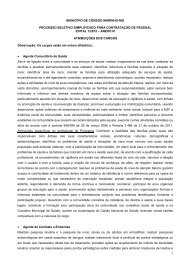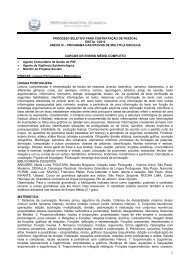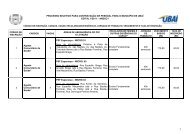Exatas - Caderno 9 - Cotec - Unimontes
Exatas - Caderno 9 - Cotec - Unimontes
Exatas - Caderno 9 - Cotec - Unimontes
Create successful ePaper yourself
Turn your PDF publications into a flip-book with our unique Google optimized e-Paper software.
1<br />
5<br />
10<br />
15<br />
20<br />
25<br />
30<br />
35<br />
Obesity in Children and Teens<br />
PROVA DE LÍNGUA INGLESA<br />
Questões numeradas de 21 a 26<br />
The problem of childhood obesity in the United States has grown considerably in recent years. Between 16<br />
and 33 percent of children and adolescents are obese. Obesity is among the easiest medical conditions to<br />
recognize but most difficult to treat. Unhealthy weight gain due to poor diet and lack of exercise is<br />
responsible for over 300,000 deaths each year. The annual cost to society for obesity is estimated at nearly<br />
$100 billion. Overweight children are much more likely to become overweight adults unless they adopt and<br />
maintain healthier patterns of eating and exercise.<br />
What is obesity?<br />
A few extra pounds does not suggest obesity. However they may indicate a tendency to gain weight easily<br />
and a need for changes in diet and/or exercise. Generally, a child is not considered obese until the weight is<br />
at least 10 percent higher than what is recommended for their height and body type. Obesity most<br />
commonly begins between the ages of 5 and 6, or during adolescence. Studies have shown that a child who<br />
is obese between the ages of 10 and 13 has an 80 percent chance of becoming an obese adult.<br />
What causes obesity?<br />
The causes of obesity are complex and include genetic, biological, behavioral and cultural factors. Obesity<br />
occurs when a person eats more calories than the body burns up. If one parent is obese, there is a 50 percent<br />
chance that their children will also be obese. However, when both parents are obese, their children have an<br />
80 percent chance of being obese. Although certain medical disorders can cause obesity, less than 1 percent<br />
of all obesity is caused by physical problems. Obesity in childhood and adolescence can be related to:<br />
• poor eating habits<br />
• overeating or binging<br />
• lack of exercise (i.e., couch potato kids)<br />
• family history of obesity<br />
• medical illnesses (endocrine, neurological problems)<br />
• medications (steroids, some psychiatric medications)<br />
• stressful life events or changes (separations, divorce, moves, deaths, abuse)<br />
• family and peer problems<br />
• low self-esteem<br />
• depression or other emotional problems<br />
What are risks and complications of obesity?<br />
There are many risks and complications with obesity. Physical consequences include:<br />
• increased risk of heart disease<br />
• high blood pressure<br />
• diabetes<br />
• breathing problems<br />
• trouble sleeping<br />
Child and adolescent obesity is also associated with increased risk of emotional problems. Teens with<br />
weight problems tend to have much lower self-esteem and be less popular with their<br />
peers. Depression, anxiety, and obsessive compulsive disorder can also occur. […]<br />
(Disponível em: http://www.aacap.org/cs/root/facts_for_families/obesity_in_children_and_teens, acesso em: 21 ago. 2012.)<br />
Processo Seletivo – <strong>Unimontes</strong> 10














